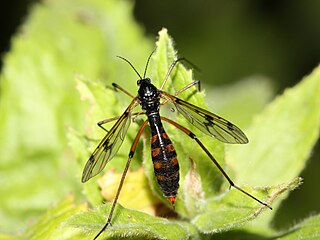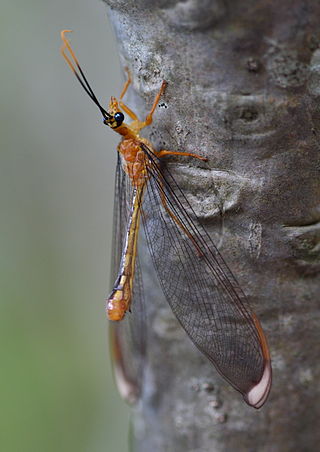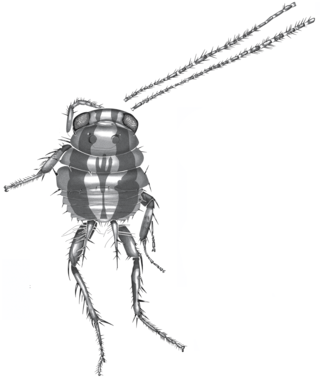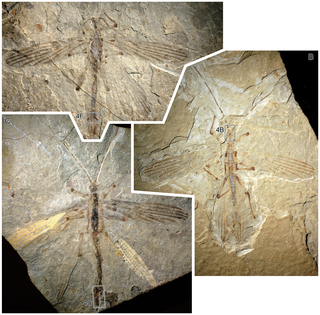
The Cupedidae are a small family of beetles, notable for the square pattern of "windows" on their elytra, which give the family their common name of reticulated beetles.

Green lacewings are insects in the large family Chrysopidae of the order Neuroptera. There are about 85 genera and 1,300–2,000 species in this widespread group. Members of the genera Chrysopa and Chrysoperla are very common in North America and Europe; they are very similar and many of their species have been moved from one genus to the other time and again, and in the nonscientific literature assignment to Chrysopa and Chrysoperla can rarely be relied upon. Since they are the most familiar neuropterans to many people, they are often simply called "lacewings". Since most of the diversity of Neuroptera are properly referred to as some sort of "lacewing", common lacewings is preferable.

Bittacidae is a family of scorpionflies commonly called hangingflies or hanging scorpionflies.

The Ptychopteridae, phantom crane flies, are a small family of nematocerous Diptera. Superficially similar in appearance to other "tipuloid" families, they lack the ocelli of the Trichoceridae, the five-branched radial vein of the Tanyderidae, and the two anal veins that reach the wing margins of the Tipulidae. They are usually allied with the Tanyderidae based on similarities of the mesonotal suture, this group being called the Ptychopteromorpha.

Anaxyelidae is a family of incense cedar wood wasps in the order Hymenoptera. It contains only one living genus, Syntexis, which has only a single species, native to Western North America. Fossils of the family extend back to the Middle Jurassic, belonging to over a dozen extinct genera, with a particularly high diversity during the Early Cretaceous. Syntexis lay eggs in the sapwood of conifers, preferring recently burnt wood.

Osmylidae are a small family of winged insects of the net-winged insect order Neuroptera. The osmylids, also called lance lacewings, stream lacewings or giant lacewings, are found all over the world. There are around 225 extant species.

Nemonychidae is a small family of weevils, placed within the primitive weevil group because they have straight rather than geniculate (elbowed) antennae. They are often called pine flower weevils. As in the Anthribidae, the labrum appears as a separate segment to the clypeus, and the maxillary palps are long and projecting. Nemonychidae have all ventrites free, while Anthribidae have ventrites 1-4 connate or partially fused. Nemonychidae lack lateral carinae on the pronotum, while these are usually present, though may be short, in Anthribidae.

The Berothidae are a family of winged insects of the order Neuroptera. They are known commonly as the beaded lacewings. The family was first named by Anton Handlirsch in 1906. The family consists of 24 genera and 110 living species distributed discontinuously worldwide, mostly in tropical and subtropical regions. Numerous extinct species have also been described. Their ecology is poorly known, but in the species where larval stages have been documented, the larvae are predators of termites.

Nymphidae, sometimes called split-footed lacewings, are a family of winged insects of the order Neuroptera. There are 35 extant species native to Australia and New Guinea.

Coptoclavidae is an extinct family of aquatic beetles in the suborder Adephaga. The Coptoclavidae lived from the Late Triassic to the Early Cretaceous. Coptoclavidae is a member of the adephagan clade Dytiscoidea, which contains other aquatic beetles. Suggested reasons for their extinction to include the rise of teleost fish, or competition with Gyrinidae and Dytiscidae, which possess defensive secretions and sucking channels in the mandibles of larvae, which coptoclavids likely lacked. It has been suggested that the genus Timarchopsis and the subfamily Timarchopsinae are only distantly related to other coptoclavids based on cladistic analysis, with Timarchopsis being more closely related to geadephagans like carabids and trachypachids instead. Another study also suggested similarly for Coptoclavisca and possibly other coptoclaviscines.

Ithonidae, commonly called moth lacewings and giant lacewings, is a small family of winged insects of the insect order Neuroptera. The family contains a total of ten living genera, and over a dozen extinct genera described from fossils. The modern Ithonids have a notably disjunct distribution, while the extinct genera had a more global range. The family is considered one of the most primitive living neuropteran families. The family has been expanded twice, first to include the genus Rapisma, formerly placed in the monotypic family Rapismatidae, and then in 2010 to include the genera that had been placed into the family Polystoechotidae. Both Rapismatidae and Polystoechotidae have been shown to nest into Ithonidae sensu lato. The larvae of ithonids are grub-like, subterranean and likely phytophagous.
Eolepidopterigoidea is an extinct superfamily of moths, containing the single family Eolepidopterigidae, although the genus Undopterix is sometimes placed in a separate family Undopterigidae. The type-genus of the family is Eolepidopterix.

The Stenophlebiidae is an extinct family of medium-sized to large fossil odonates from the Upper Jurassic and Cretaceous period that belongs to the damsel-dragonfly grade ("anisozygopteres") within the stem group of Anisoptera. They are characterized by their long and slender wings, and the transverse shape of the discoidal triangles in their wing venation.

Chresmoda is an extinct genus of insects within the family Chresmodidae.
Locustopsidae is an extinct family of grasshoppers in the order Orthoptera. There are about 17 genera and more than 60 described species in Locustopsidae.

Blattulidae is an extinct family of cockroaches known from the Triassic to the Late Cretaceous. Their distinguishing characteristics include "forewing has long Sc, regular venation with distinct intercalaries and hindwing has simple CuP, branched A1."
Mesoblattinidae is an extinct family of cockroaches known from the Mesozoic. It was formerly considered a wastebasket taxon for Mesozoic cockroaches, but the family has subsequently been better defined, with many taxa transferred to Caloblattinidae. It is considered to have close affinities with Blattidae and Ectobiidae, as well as possibly Blaberidae. The family first appeared by the Early Jurassic. They are considered to represent amongst the oldest groups of modern cockroaches, and like them are thought to have laid oothecae.
Liberiblattinidae is an extinct family of cockroaches known from the Jurassic to Cretaceous. Some taxa, like Cryptoblatta and Hydrokhoohydra, are suggested to be semiaquatic. Spongistoma is suggested to be a nectarivore due to its unique sucking/sponging "proboscis" mouthparts. Some authors have suggested that the family is ancestral to Mantodea.
Praeaulacidae is an extinct family of Mesozoic parasitic wasps in the suborder Evanioidea. It among the earliest known families of the group and is characterised by more complete wing venation in comparison to other members of the suborder. It has been found that Othniodellithidae is nested within Praeaulacidae via cladistic analysis.

Susumanioidea is an extinct superfamily of Phasmatodea, known from the Middle Jurassic to Eocene. They lie outside the modern crown group of Phasmatodea. Members of the group typically possess large, fully developed wings.














